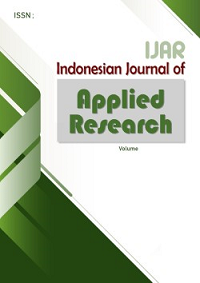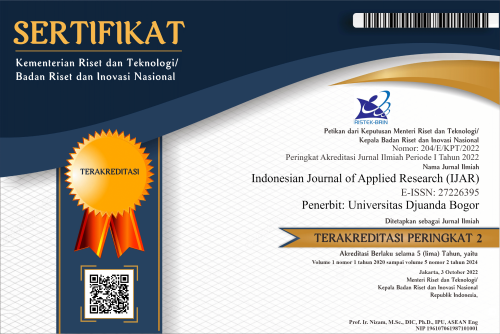The Effect of Concentration and Frequency of Neem Leaf Extract on Aphid Attacks on Chili Plants
Abstract
Aphids that attack red pepper plants cause yield loss. Applying neem leaf extract in the form of concentration and frequency of yield losses can be avoided. Neem leaf extract contains secondary metabolite compounds that can function as vegetable insecticides to suppress the level of aphid attacks on chili plants. Saponins, meliantriol, and azadirachtin have been known as active ingredients that act as insecticides with different mechanisms of action against aphids, such as saponins as stomach poisons and contact poisons, meliantriol as a repellent (repellent/repellent), and azadirachtin as an inhibitor of ecdysone hormones (hormones that play a role in the process of metamorphosis or molting or exoskeleton of aphids). The study aimed to determine the effect of concentration and frequency of neem leaf extract on the incidence and severity of chili aphid attacks as well as plant development. The proposed solution to overcome aphid attacks is administering neem leaf extract to red chili plants. The method uses a randomized trial design of factorial groups with two factors. The first factor is the concentration of neem leaf extract which consists of four levels, namely: S0 = 0% (100 ml of water or without neem leaf extract), S1 = 10% (10 ml of neem leaf extract + 90 ml of water), S2 = 30% (30 ml of neem leaf extract + 70 ml of water), and S3 = 50% (50 ml of neem leaf extract + 50 ml of water). The second factor is the frequency of giving neem leaf extract, which consists of four levels: M1 = age 8 HSPT, M2 = age 16 HSPT, M3 = age 24 HSPT, and M4 = age 32 HSPT. The findings of this study are that the frequency of giving neem leaf extract three times showed a real effect on the severity of aphid attacks at the age of 44 days after transplanting, and giving a 10% extract had a real effect on height, leaf area, number of flowers, header dry bobobt, and dry weight of chili plant roots. The results of this study conclude that the administration of neem leaf extract can suppress the severity of the attack of red chili plant aphids.
References
Acharya, P., Mir, S. A., & Nayak, B. (2017). Competence of Biopesticide and Neem in Agriculture. International Journal of Environment, Agriculture and Biotechnology (IJEAB), 2(6), 2958–2965. https://doi.org/http://dx.doi.org/10.22161/ijeab/2.6.23 Vol-2,
Adusei, S., & Azupio, S. (2022). Neem : A Novel Biocide for Pest and Disease Control of Plants. Journal of Chemistry, 2022. https://doi.org/10.1155/2022/6778554
Ali, S., Haq, M. A., Naz, S., & Faheem Akbar, M. (2022). Gum cordia effectively enhances foliage adhesion of neem oil and increases its efficacy against aphids (Homoptera: Aphididae). Journal of Asia-Pacific Entomology, 25(2), 101904. https://doi.org/10.1016/j.aspen.2022.101904
Aziz, W., Shalaby, M., & Tawfik, W. (2018). Efficacy of some Essential Oils on Cowpea Aphid, Aphis craccivora Koch (Hemiptera: Aphididae). Journal of Plant Protection and Pathology, 9(12), 827–830. https://doi.org/10.21608/jppp.2018.44074
Birgücü, A. K., Özger, Ş., Pohl, D., & Karaca, İ. (2018). Effects of soil application of neem on some biological characteristics of myzus persicae (Sulzer) (hemiptera: Aphididae). Tarim Bilimleri Dergisi, 24(2), 256–268. https://doi.org/10.15832/ankutbd.446452
Biswas, G. C. (2013). COMPARATIVE EFFECTIVENESS OF NEEM EXTRACTS AND SYNTHETIC ORGANIC INSECTICIDE AGAINST MUSTARD APHID. 38(June), 181–187. https://doi.org/10.3329/bjar.v38i2.15881
Dhakal, R., Ghimire, R., Sapkota, M., Thapa, S., Bhatta, A. K., & Regmi, R. (2019). BIOEFFICACY OF DIFFERENT INSECTICIDES ON COWPEA APHID (APHIS CRACCIVORA KOCH) Roshan. International Journal of Entomological Research, 07(01), 1–9. https://doi.org/10.33687/entomol.007.01.2629
Dimetry, N. Z., & El-hawary, F. M. A. (1997). SYNERGISTIC EFFECT OF SOME ADDITIVES ON THE BIOLOGICAL ACTIVITY AND TOXICITY OF NEEM-BASED FORMULATIONS AGAINST THE COWPEA APHID, APHIS CRACCIVORA KOCH. Insect Sci. Applic, 17(3), 395–399. https://doi.org/10.1017/s174275840001924x
Ghosh, S. K. (2020). Aphid (Aphis craccivora Koch.) Management on Groundnut Crop (Arachis hypogaea) by using Bio-pesticides. International Journal of Current Microbiology and Applied Sciences, 9(10), 24–34. https://doi.org/10.20546/ijcmas.2020.910.004
Haerul, Idrus, M. I., & Risnawati. (2016). Efektifitas Pestisida Nabati Dalam Mengendalikan Hama Pada Tanaman Cabai. Agrominansia, 3(2), 129–136. https://doi.org/10.34003/271888
Hasibuan, M., Delina, E., & Zulhaida, L. (2021). Pemanfaatan Daun Mimba ( Azadirachta indica ) sebagai Pestisida Nabati : Review. 5(1), 1153–1158.
Ikeura, H., Murata, N., Sakura, A., Hayata, Y., & Kobayashi, F. (2013). Search for neem materials having repellent effect against green peach aphid (Myzus persicae Sulzer). International Society for Horticultural Science, 989, 97–102. https://doi.org/10.17660/ActaHortic.2013.989.10
Javandira, C., Yuniti, I. G. A. D., & Widana, I. G. (2022). Pengaruh Pestisida Daun Mimba terhadap Mortalitas Kutu Daun (Aphis craccivora Koch) pada Tanaman Kacang Panjang. Agro Bali : Agricultural Journal, 5(3), 485–491. https://doi.org/https://doi.org/10.37637/ab.v5i3.998
Kareem, K. T., Olayinka, R. B., Ugwu, J. A., & Oduwaye, O. F. (2022). Effects of Neem Aqueous Extract (Azadirachta indica) against Aphids and Aphid-borne Virus in Cowpea (Vigna unguiculata L. Walp). Tanzania Journal of Science, 48(1), 47–56. https://doi.org/10.4314/tjs.v48i1.5
Maharani, S., Sepriani, Y., & Walida, H. (2020). Pengaruh Ekstrak Daun Mimba (Azadirachta indica Juss) Terhadap Mortalitas Hama Kutu Kebul (Bemisia tabaci). Agustus, 1(2), 55–60.
Mohapatra, S., Gogoi, I., Bhattacharyya, B., Nath, P. D., & Neog, B. (2021). Efficacy of some indigenous products against cowpea aphid, Aphis craccivora Koch. Indian Journal of Traditional Knowledge, 20(3), 822–826. https://doi.org/10.56042/IJTK.V20I3.28261
Pissinati, A., & Venture, M. U. (2015). Control of cabbage aphid, Brevicoryne brassicae (L.) using kaolin and neem oil. Journal of Entomology, 12(1), 48–54. https://doi.org/10.3923/je.2015.48.54
Rajab, A. M., Hayati, A., & Zayadi, H. (2018). Pengaruh Larutan Kombinasi Daun Mimba (Azadirachta indica) dengan Buah Cabai Rawit (Capsicum frutescens) terhadap Mortalitas Kutu Daun Hijau (Aphis gossypii) Secara In Vitro. Jurnal SAINS ALAMI (Known Nature), 1(1), 1–6. https://doi.org/10.33474/j.sa.v1i1.1390
Roychoudhury, R. (2016). Neem Products. Ecofriendly Pest Management for Food Security, 545–562. https://doi.org/10.1016/B978-0-12-803265-7.00018-X
Saleem, U., Asrar, M., Hussain, D., Hussain, S., Ghaffar, A., & Usman, H. (2023). Efficacy of Plant Extracts and Selective Insecticides Against Wheat Aphid in Faisalabad, Pakistan. 9(1), 65–71.
Sarvaiya, R. M., Rathod, N. P., & Patel, R. M. (2018). Bio-Efficacy of Bio-Pesticides against Aphid, Aphis craccivora Koch Infesting Fenugreek. International Journal of Current Microbiology and Applied Sciences, 7(10), 2634–2640. https://doi.org/10.20546/ijcmas.2018.710.306
Shannag, H. S., Capinera, J. L., & Freihat, N. M. (2014). Efficacy of different neem-based biopesticides against green peach aphid, Myzus persicae (Hemiptera : Aphididae). International Journal of Agricultural Policy and Research, 2(2), 61–68.
Stella, A. E., Flarian, M. M., & Tedson, M. J. (2018). Efficacy of Neem Tree (Azadirachta indica A. Jusieu) Extract on White Cabbage Aphid (Brevicoryne brassicae L. (Hem: Aphididae) Control in the field. Journal of Agricultural Science, 10(3), 370. https://doi.org/10.5539/jas.v10n3p370
Syakur, A., Hasrianty, Alam, M. N., & Asrun, B. (2022). Pengaruh Pemberian Ekstrak Daun Mimba(Azadirachta india A. Juss) Terhadap Hama Kutu Daun(Aphis craccivora) Pada Tanaman Terong (Solanum melongena L). Jurnal Pendidikan Biologi, 7(2), 258–265.
Tobing, O. L., & Mulyaningsih, Y. (2020). THE RECONDITIONING GROWTH OF PRODUCTION OF CHILI THROUGH THE BANANA HUMP AND MIMBA LEAF EXTRACT. Indonesian Journal of Applied Research, 1(3), 136–149. https://doi.org/10.30997/ijar.v1i3.71
Copyright (c) 2023 Indonesian Journal of Applied Research (IJAR)

This work is licensed under a Creative Commons Attribution-ShareAlike 4.0 International License.
The Authors submitting a manuscript do so on the understanding that if accepted for publication, copyright publishing of the article shall be assigned/transferred to Indonesian Journal of Applied Research (IJAR) Universitas Djuanda as Publisher of the journal. Upon acceptance of an article, authors will be asked to complete a 'Copyright Transfer Agreement'. An e-mail will be sent to the corresponding author confirming receipt of the manuscript together with a 'Copyright Transfer Agreement' form by online version of this agreement.
Indonesian Journal of Applied Research (IJAR) Universitas Djuanda, the Editors and the Editorial Board make every effort to ensure that no wrong or misleading data, opinions or statements be published in the journal. In any way, the contents of the articles and advertisements published in the Indonesian Journal of Applied Research (IJAR) Universitas Djuanda are sole and exclusive responsibility of their respective authors and advertisers.
Remember, even though we ask for a transfer of copyright, our journal authors retain (or are granted back) significant scholarly rights as mention before.
The Copyright Transfer Agreement (CTA) Form can be downloaded here: Copyright Transfer Agreement-IJAR 2020
The copyright form should be signed electronically and send to the Editorial Office e-mail below:
Prof. Dr. Ir. Dede Kardaya, M.Si. (Editor-in-Chief)
Universitas Djuanda
Jl. Tol Jagorawi No.1, Ciawi, Kec. Ciawi, Bogor, Jawa Barat 16720
Website: http://journal.unida.ac.id/index.php/IJAR/index
Email: ijar@unida.ac.id






 This work is licensed under a
This work is licensed under a 